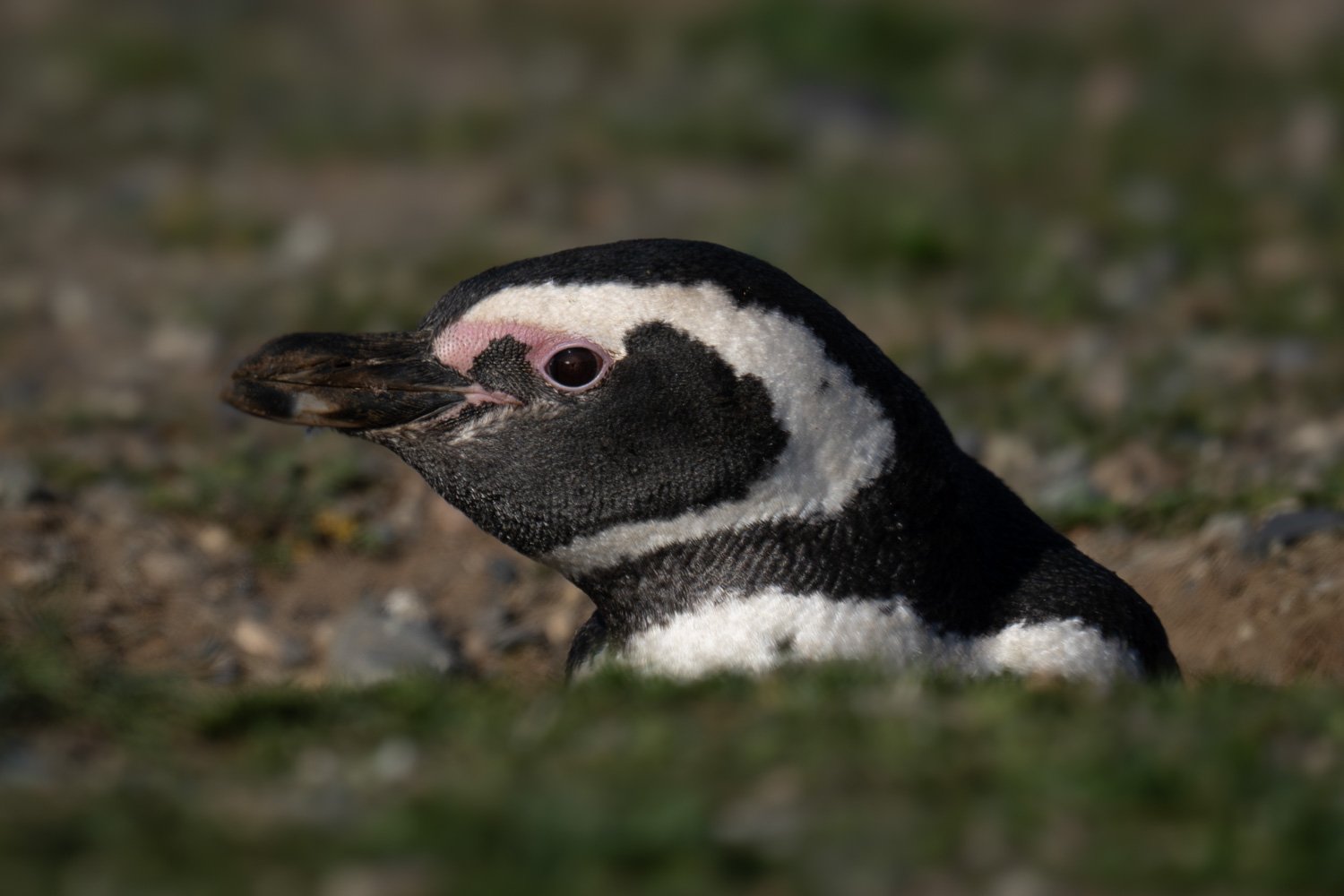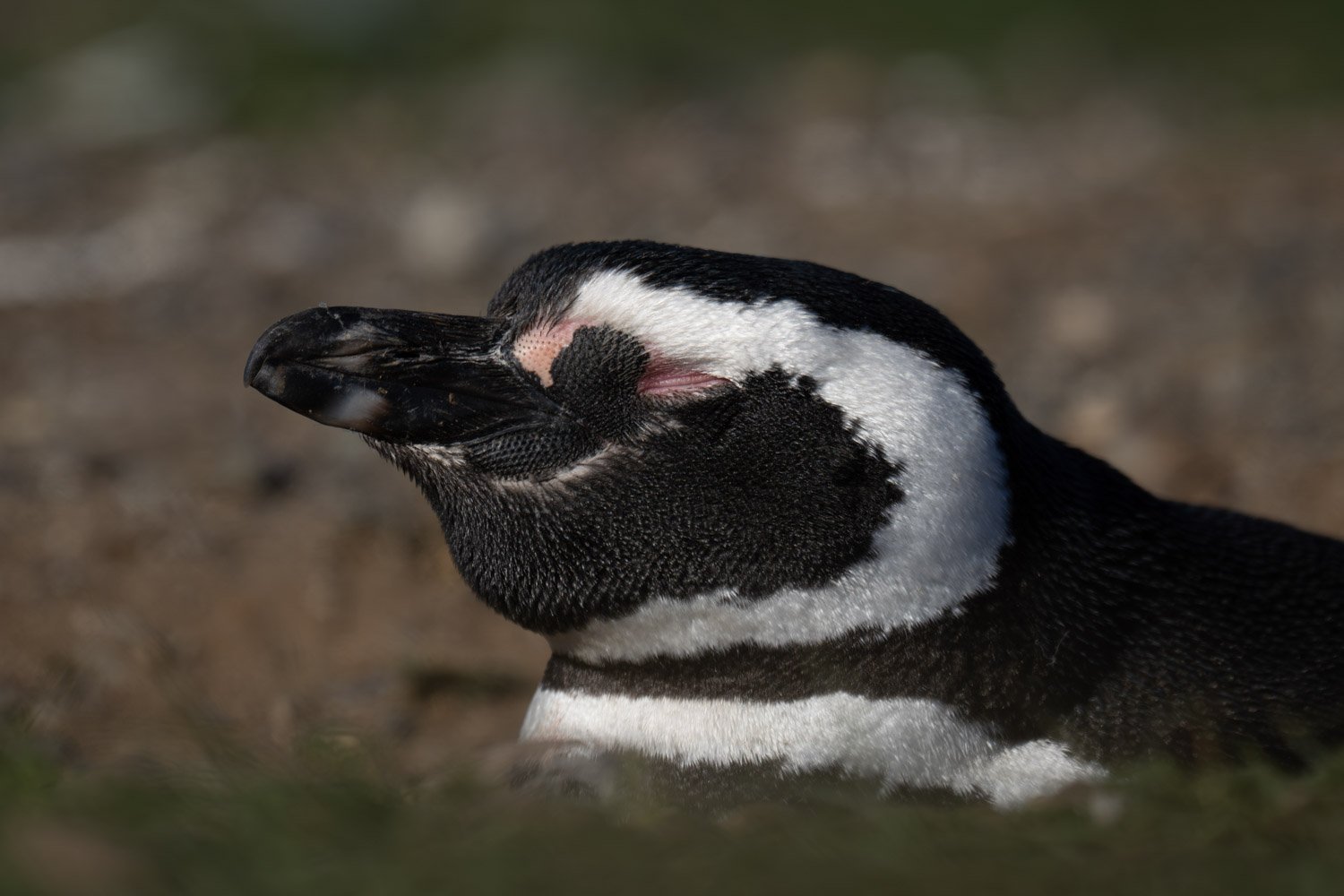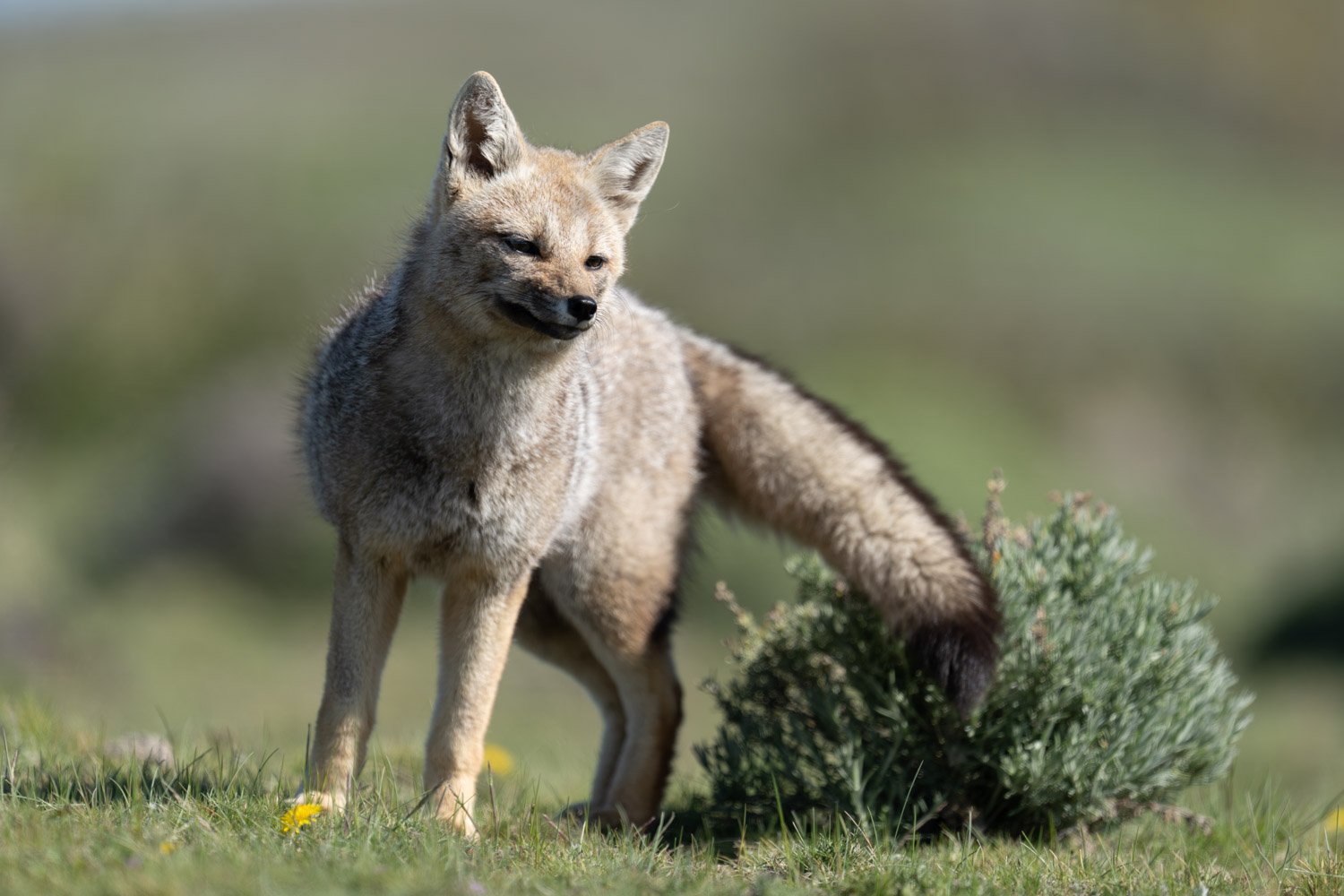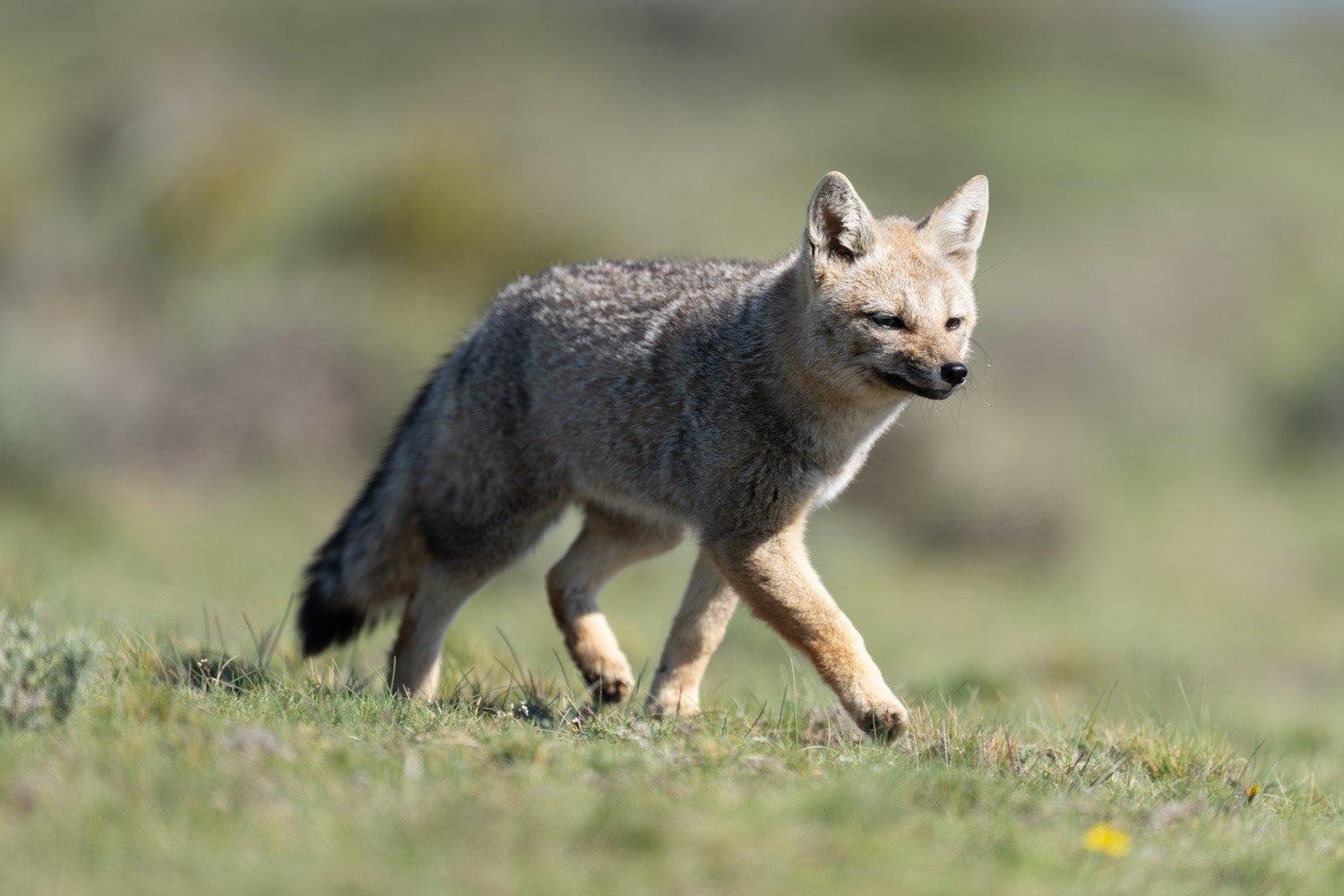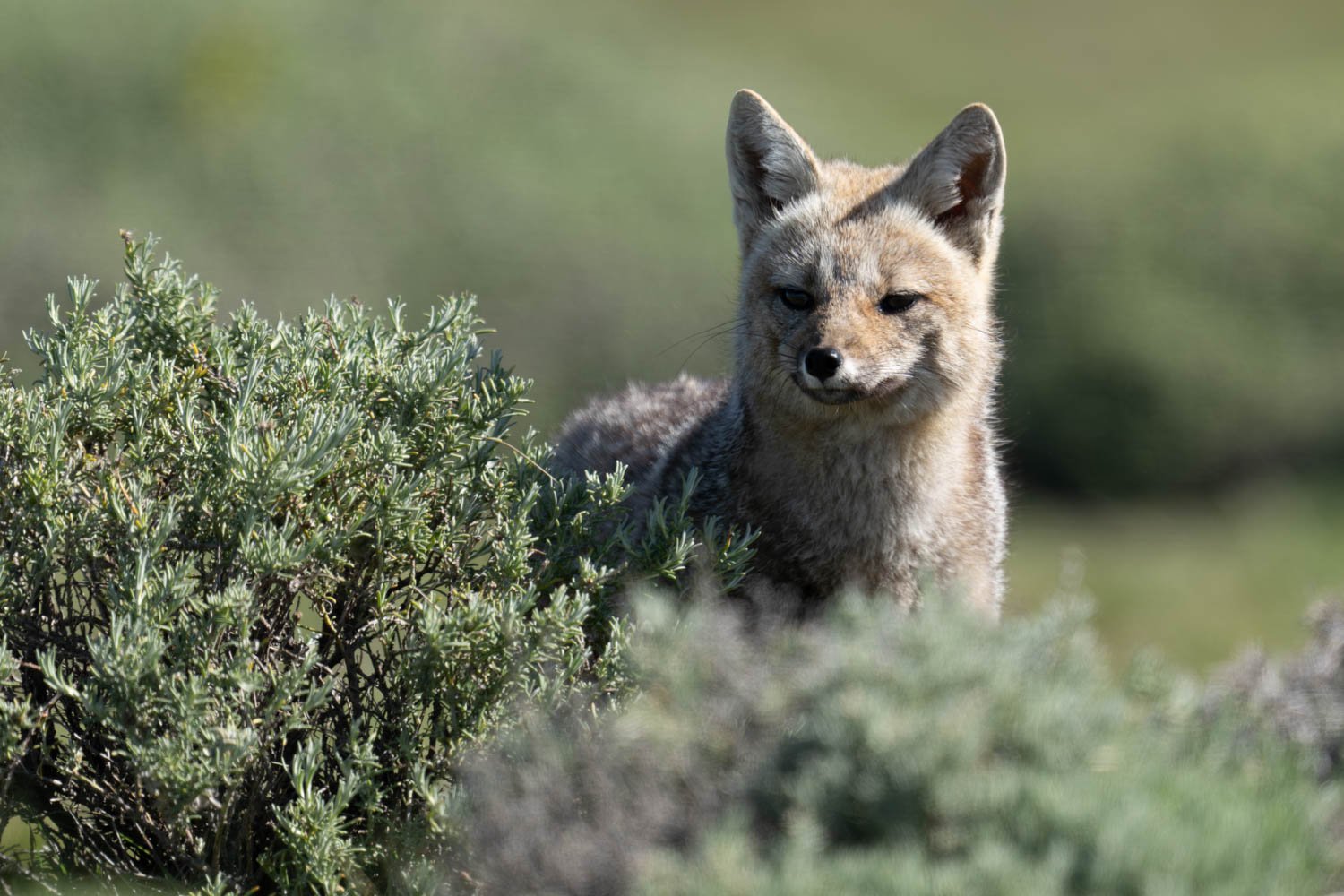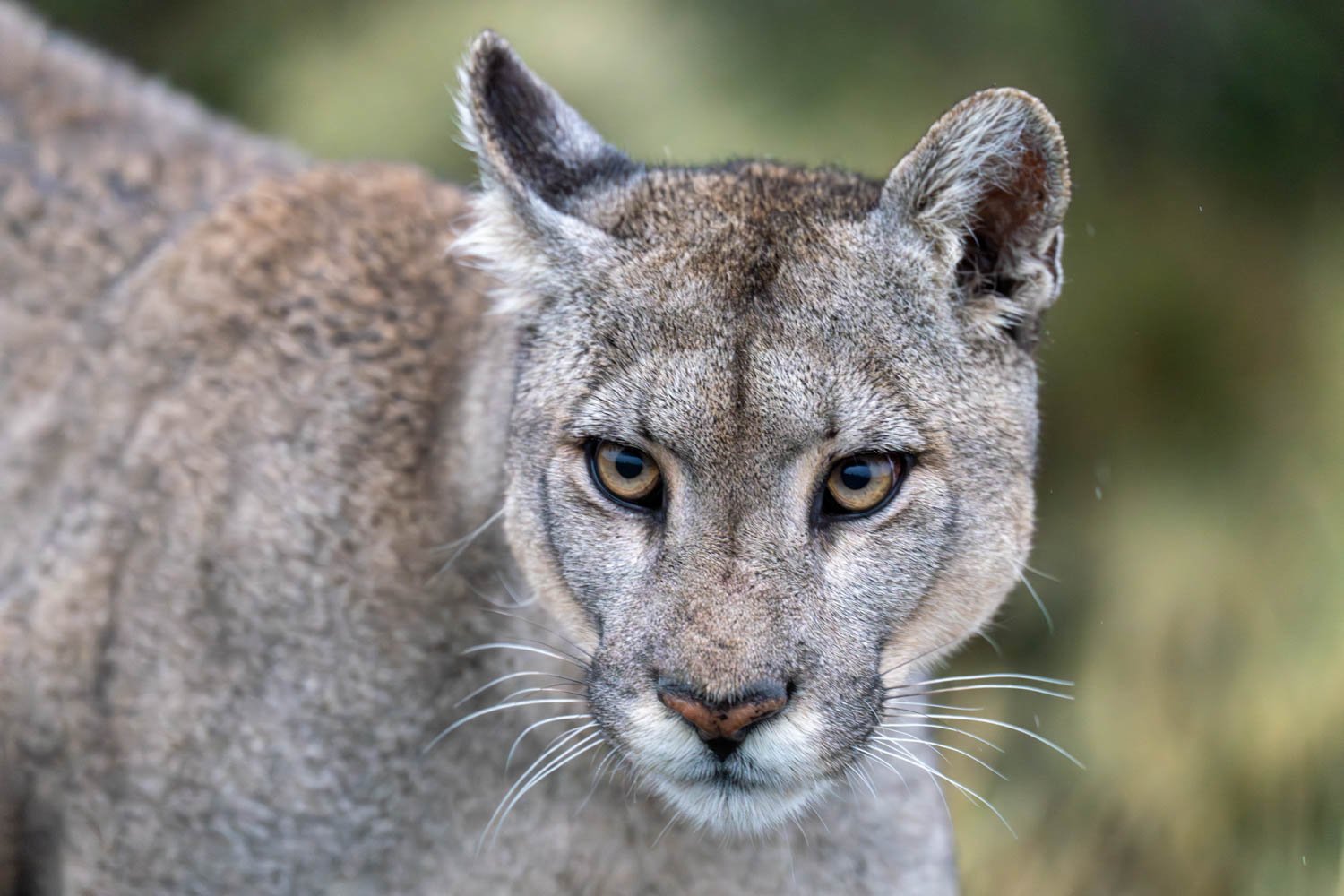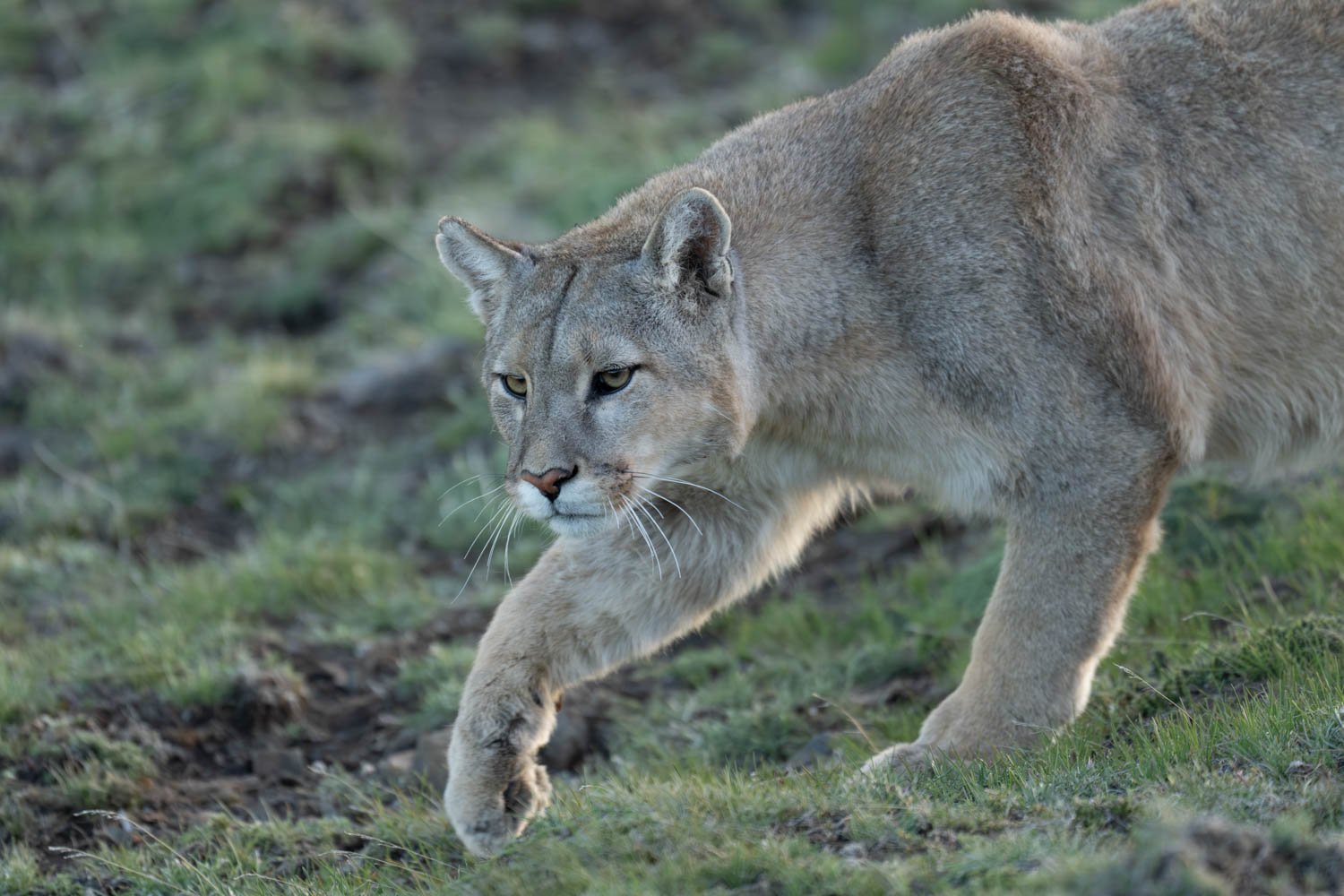Windy Paine
It’s raining cats and guanacos…
Puma
Sea lions, penguins, foxes, pumas, guanacos, rheas, condors, short-eared owls, American tourists, Spanish speakers, Singer sewing machines, waterfalls, sunshine, snow, rain, lenticular clouds, wind, wind and more wind—and did I mention the wind?! That’s what you get when you travel to Torres del Paine in Chile.
I’ve just spent a week there with Hector Astorga and three other guests. There were no kills, no young cubs and no chances to take pictures during the golden hour. As a result, I didn’t take any great photos, but it was still very enjoyable. After a boat trip to see sea lions and Magellanic penguins, we saw pumas every day (10 unique animals with eight ‘repeats’), and the only problem we had was the weather.
It started out nice and sunny, but then the temperature plummeted, the wind picked up, and it started snowing. On the final day, the weather was bad enough to spoil our morning doing landscape photography at a local waterfall, and we had to cancel a trip to see the Andean condor.
Anyway, here’s a quick rundown of the highlights…
Itinerary
You can find the full itinerary on Hector’s website, but the ‘land’ portion ran from 21-29 October 2023. It included a morning with the Magellanic penguins on Magdalena Island, five days tracking the puma at the Estancia Laguna Amarga (next door to the Torres del Paine National Park) and a morning of landscape photography at the Cascada Rio Paine waterfalls (plus the cancelled trip to the Andean condor roost).
Getting There
It’s a pain to get to Torres del Paine from anywhere except Torres del Paine! Booking flights was a nightmare, and it took me the best part of three days to get to a place where I could actually take pictures!
I took a 14-hour flight from London Heathrow to Santiago, Chile, where I had a 14-hour layover. If you have that amount of time to kill, I wouldn’t recommend spending them in Santiago airport! It didn’t have any lounges or cafés with comfy seats and power outlets, and almost everywhere sold Pepsi and Bilz (!) rather than Coke, but at least I found my favourite Lay’s ruffled ready salted potato chips and my power adaptor worked!
I then took an overnight flight to Punta Arenas, arriving at 0140 on 21 October. It was such an early arrival time that Hector accidentally booked my taxi for 1:40 pm rather than 1:40 am! Fortunately, I confirmed my flight details just in time, and the taxi driver took me to the Apart Hotel Endurance. (It happened again on the way home…)
That Saturday was just the ‘arrival day’, so there was nothing much to do before having dinner at a local restaurant with Hector, his two guides, Suzy and Naun, and the other guests, Louise, Scott and Carol. Fortunately, the hotel had decent Wi-Fi, so I could write my weekly blog post and amuse myself by watching England lose to South Africa in the Rugby World Cup semi-final…!
Both staff and guests were easy to get along with, and we had a good laugh along the way. I’ve almost always been lucky enough to travel with good people on my photographic trips, and this one was no exception.
When we were tracking the puma, we had morning and evening game drives in two Toyota 4Runners. In the old days, we’d have had to park on the road and hike up the hillside to see the pumas, but the landowner has now criss-crossed the estancia with a network of grassy tracks. That meant we didn’t have to hike nearly as far.
Staying There
The accommodation was comfortable rather than luxurious, but that was fine by me. I don’t go on photographic trips for the food or the high thread-count Egyptian cotton sheets! At all-inclusive resort hotels and lodges, I used to eat whatever I liked. Now, I eat whatever I actually like. Big difference…!
The Apart Hotel Endurance had Wi-Fi, but it was an ‘apartment hotel’ (hence the name), so it didn’t have a restaurant or bar. Instead, the staff left ham, cheese, bread, a muffin and a bag of snacks in each room. There were also a few eggs, which I mistakenly thought must’ve been hard-boiled. No such luck. That cost me a trip to the bathroom after cracking one open in my fingers…!
The Hotel Ovejero Patagonico (or ‘Patagonian Shepherd Hotel’) was a large, rustic lodge with a bizarre number of old Singer sewing machines in the hallways and rooms. It had Wi-Fi in the reception area and the restaurant, but they were at opposite ends of the main corridor—and it was a long corridor, so you had to make sure you went the right way! What amused me most was the service in the restaurant. The staff were very polite and friendly, but they were constantly messing up our orders, giving us the wrong dishes or leaving out drinks from our breakfast bags. On one occasion, we had to drink our juice boxes without straws…!
Penguins, Pumas and Waterfalls
The main purpose of the trip was to see the puma, which was the only big cat that I hadn’t yet managed to photograph. Torres del Paine in Chile is the only place in the world where you can do that, so that’s why I was so keen to take part in Hector’s trip.
Magellanic Penguins
We started off the photographic part of the trip by taking a boat ride out to Magdalena Island. On the way, we saw lots of seabirds and a few South American sea lions. I managed to lose my lens cap overboard, but I cheered up when a pretty girl asked if I had an Instagram account and took a picture of my fleece logo so she could follow me!
South American sea lions
Once we got to the island, we had a chance to photograph the Magellanic penguins. These penguins are quite small—but very cute! I stayed near the dock and watched them as they waddled down the grassy slope from the lighthouse to the beach.
Pumas
The whole point of this trip was to see the puma (Puma concolor), otherwise known as the cougar, mountain lion or American lion.
Pumas are unlike most big cats as the females are territorial. The males simply wander around looking for mating opportunities and then move on, leaving the females to bring up the cubs.
After taking the boat back from Magdalena Island, we had lunch in Punta Arenas at another Italian restaurant and then drove to the Hotel Ovejero Patagonico in the Torres del Paine area, where we had dinner together.
The following morning, we made the hour-long drive to the Estancia Laguna Amarga, a 17,000-acre private ranch where there are three or four dominant female pumas. I was in the vehicle with Hector and Naun while Scott, Carol and Louise were with Suzy. It stayed like that for the whole trip.
We’d only been searching for a few minutes when one of the trackers found a mother with three of her older cubs at a kill. We drove as close as we could on the grassy tracks and then hiked up the hillside to get to within 20 yards of them. The weather was perfect, so we could all take plenty of pictures in the sunshine.
In the afternoon, we went back to the same place. On the way there, we were lucky enough to see a Patagonian grey fox in a field by the side of the road. We stopped the car and got out to take pictures. Naun and Hector made mouse noises to attract it, and it worked! The fox came running towards us, and I managed to take a few action shots.
When we finally made it to the estancia, we found the same four cats again. They didn’t do much except sleep and eat, but Hector and I did manage to get a good close-up of one of them in the early evening.
We also saw a few guanacos (or wild llama). There are two subspecies of guanaco, and this was the Lama guanicoe guanicoe or southern guanaco. The best moment came when one of them was illuminated by the last rays of the setting sun.
The following day, we went back to the same place and found a guanaco gambolling on the horizon.
Jumping for Joy
We also saw three of the original four cats, one of the cubs having gone missing. After a couple of hours of waiting for the cats to ‘activate’, they eventually walked down to a pond in the next valley. Hector, Naun and I followed them, but it was too tricky for the others, so they stayed behind.
It was a good job that I’d managed to stick with Hector, though, as we saw one puma on the ridge and two of them lying down together to drink.
Another tracker called Victor joined us, but we finally lost sight of the pumas when they all jumped over the fence into Torres del Paine National Park.
Later that morning, Hector and I and then the rest of the group had the chance to take a few pictures of guanacos against the ‘towers’ of Torres del Paine.
After lunch, I got up to date with my photos, and we went out again in the afternoon. We saw a few guanacos but no pumas. There was nothing much happening, so we had to find things to occupy our time:
Hector helped me with my video settings.
I asked if there were any dolphins or whales in a long stretch of water nearby. It turned out to be a lake!
I dropped one of my AirPods in the jeep, but I was lucky enough to find it.
We saw a lenticular cloud over the mountains.
Our expedition finally came to an end when the other vehicle got stuck in a muddy puddle on the way to see a puma. Instead, Victor took us back to the hotel. Fortunately, he met someone on the way who had a spare tow rope, so they could pull the car out.
After dinner, Hector fixed my tripod plate with his Leatherman tool. Hurrah!
In the morning, the wind was ‘brutal’ (to use Hector’s word for it). Down here, they call it God’s Broom or the Devil’s Broom! It certainly felt like we were about to be swept off the face of the earth, and Naun even fell over a couple of times when he had to leave the car.
While we were waiting for a puma sighting, Hector told me the names of a few of the areas in the estancia:
The Office (because you could get a mobile signal from the top)
The Boobs (because they looked like, er, boobs!)
Antenna (because there used to be an antenna there)
In the end, we didn’t see anything, so we came back a bit early.
In the afternoon, we saw a lone puma in the rain, but it wasn’t ‘habituated’, so it ran away. I had to put my rainproof covers on my camera and wear my outer gloves for the first time, but everything seemed to work all right.
We saw another puma called Petaca, who was the star of a recent Disney documentary. She was eating a hare in the undergrowth, so it was hard to get a clean shot. She then walked away. I tried to go long, but I wasn’t fast enough with my tripod and two cameras. Hector ended up right next to her when she posed, and he and Naun got the money shot when she walked straight towards them. When she eventually lay down, I had to content myself with portraits again. It was the usual cat routine: hunt, eat, preen and sleep.
We were the only people to see a puma that day, so it was a good job Hector kept the trackers at work during lunchtime.
When we went outside in the morning, there was snow on the jeeps! We went out looking for Petaca again. Suzy saw a puma but then lost it, and then we had a blizzard! We did eventually see a puma, but it was bedded down with too many people around it. We got a few shots, but nothing special. The most entertaining moment came when one of the photographers walked away from his camera and tripod, and the whole thing fell over in the wind!
After lunch, we found a male and a female (Sol). The male left quite soon, but we stayed with Sol while she napped. And she napped for a long, long time…!
On the way home, we saw a short-eared owl, which is apparently very rare in these parts. Naun told me he hadn’t managed to take a photo of one in eight years! I got a few portraits but not a shot of it taking off. It was very dark, and I should maybe have prioritised take-off rather than lowering my shutter speed to reduce the ISO. Having said that, the ISO would’ve been astronomical unless I’d chosen to try a slow pan…
On our final day of puma tracking, we saw one almost at once. He went to a group of rocks and walked straight towards me at one point. He then nestled down in the rocks for a long time. We were hoping he’d climb on top so that we could get a shot of the puma against the background of the snow-capped mountains behind, but he never did. Too bad…
In the afternoon, the wind was so ‘brutal’ we couldn’t take pictures of the male puma, so we had a long wait. At least I discovered how to switch my EVF to black and white. When the puma finally moved, it was after sunset, and we only got about 20 seconds of action.
Waterfalls
Our last activity was a trip to a local waterfall called the Cascada Rio Paine. We could’ve gone back to the estancia, but we’d have had to pay for the whole day, and we had to drive back to Punta Arenas in the afternoon, so Hector decided to book a morning of landscape photography.
We took pictures of the waterfalls using wide-angle lenses in aperture priority mode, bracketing our shots by one stop each way and using slow shutter speeds to give the water a creamy texture. Hector visited each of us in turn to give us a few tips, and it was fun to experiment with different shutter speeds and black and white, but once I’d taken pictures at three of four of the best spots, there wasn’t much left to do!
When I was unloading my camera bag back at the hotel, I managed to drop my 12-24mm lens! It had both caps on and seemed okay, but the shock obviously can’t have been good for it.
I packed my gear, and we drove to another Italian place for lunch in Puerto Natales. Sadly, the weather was too bad to photograph the condors, so we drove all the way back to Apart Hotel Endurance in Punta Arenas. It took us about four hours, but I had my laptop with me, so I spent the time editing my photos.
Back at the Apart Hotel Endurance, I started writing this blog post…
Verdict
I’m very glad I went on this trip. The staff and guests were good company, and Hector was both professional and good-humoured the whole time. He didn’t do that much teaching, but that’s just his personal style. I don’t really need that much help anyway, and he was always happy to answer any questions I had about photography or the local wildlife.
How much I enjoy a photographic trip usually depends on how many five-star images I manage to take—and I didn’t take any on this occasion! Despite what Stalin said about the T-34 tank, ‘quantity doesn’t have a quality all of its own’ when it comes to pumas!
However, I’m glad I managed to tick the puma off my ‘life list’, and it was fun to chat with the other guests. We generally had a lot of laughs, and my gear stood up pretty well to the weather.
Hector runs a lot of different workshops, so I hope I can go on another one at some stage—although the Zimanga trip I was thinking about is already sold out next year, so I might have to go in 2025!
We shall see…
Butcher’s Bill
1 x lens cap
1 x grey woolly hat
1 x nail file
Species List
Animals
Chilean dolphin
Guanaco
Puma
South American grey fox
South American sea-lion
Birds
Andean condor
Australia negrito
Black-faced ibis
Black-necked swans
Chilean flamingo
Chimango caracara
Cinereous harrier
Cinnamon-faced ground-tyrant
Common mynah
Crested duck
Imperial cormorant
Long-tailed meadow lark
Magellanic diving-petrel
Magellanic penguin
Neotropic cormorant
Ochre-naped brown tyrant
Rhea
Rufous collared sparrow
Short-eared owl
Snowy sheathbill
Southern crested caracara
Southern giant petrel
Southern lapwing
Speckled teal
Upland goose
If you’d like to order a framed print of one of my wildlife photographs, please visit the Prints page.
If you’d like to book a lesson or order an online photography course, please visit my Lessons and Courses pages.



